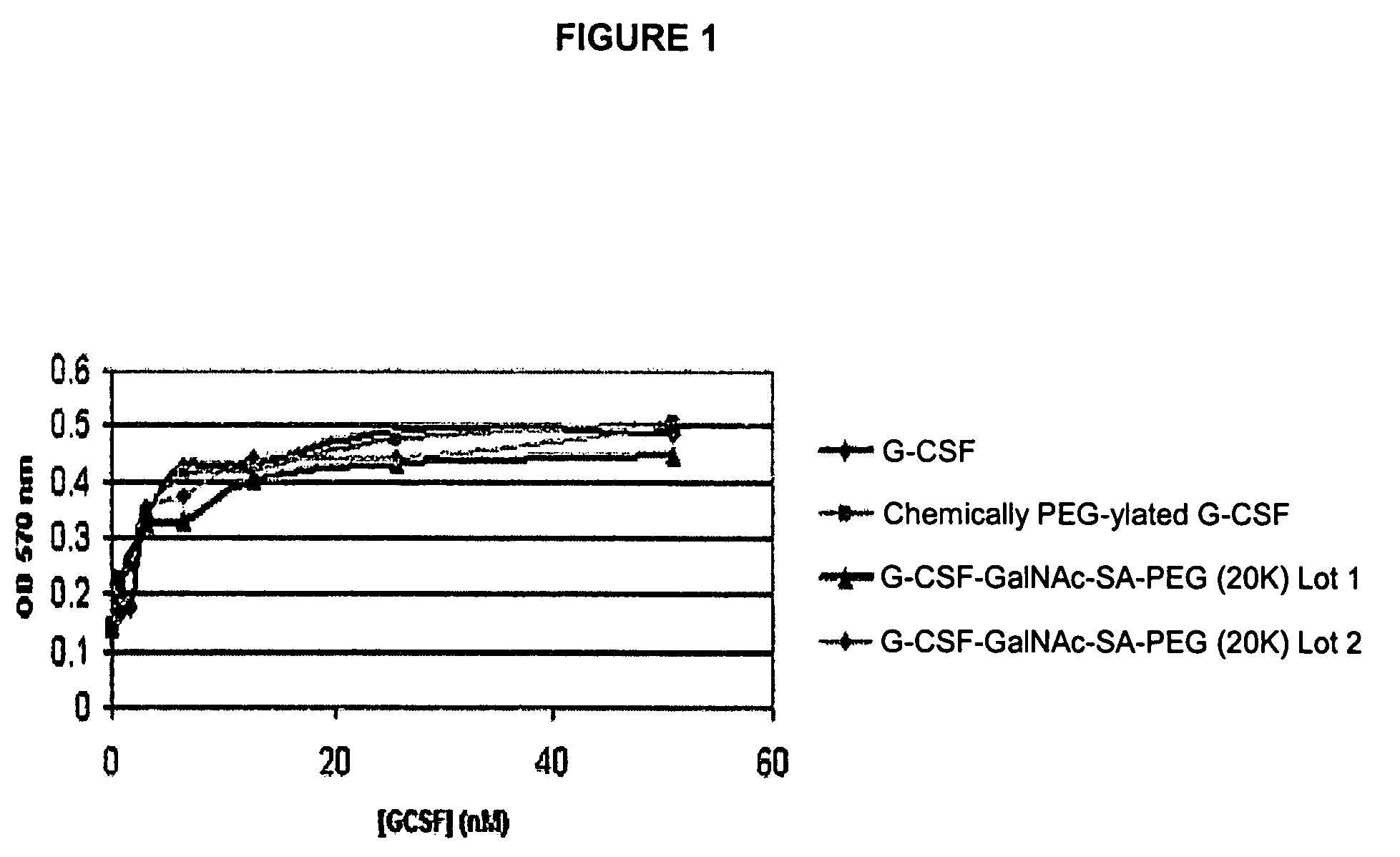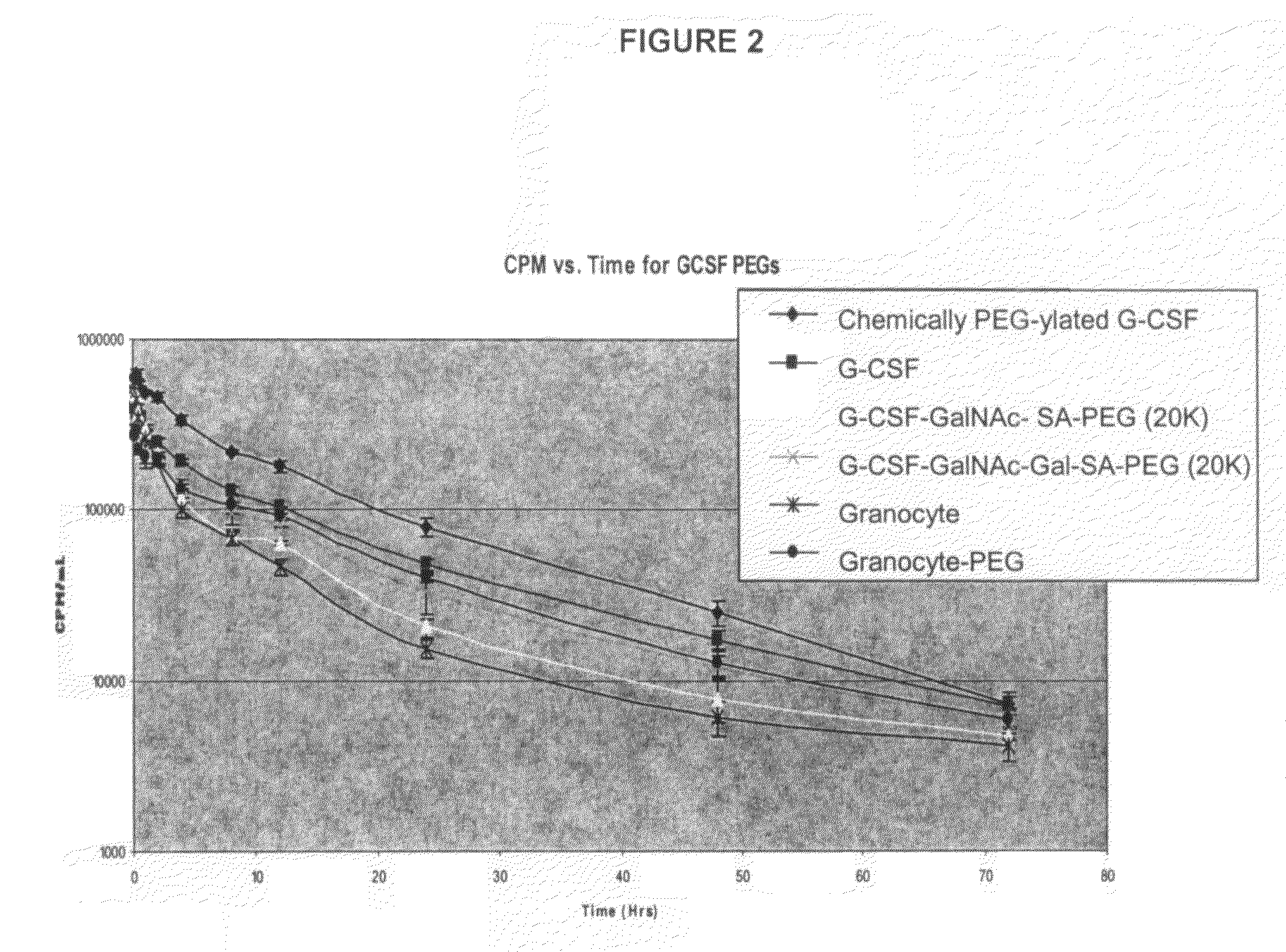O-linked glycosylation of peptides
a glycopeptide and glycosylation technology, applied in the field of olinked glycosylation glycopeptides, can solve the problems of limited use of therapeutic peptides, difficulty inherent in engineering an expression system, and neutralization of peptides
- Summary
- Abstract
- Description
- Claims
- Application Information
AI Technical Summary
Benefits of technology
Problems solved by technology
Method used
Image
Examples
example 1
1.1a Preparation of Interferon alpha-2β-GalNAc (pH 6.2)
[0526]Interferon alpha-2β was reconstituted by adding 200 μL water to 4 mg of IFN alpha-2β. When the solid was dissolved, 1.92 mL reaction buffer (20 mM MES, pH 6.2, 150 mM NaCl, 5 mM MgCl2, 5 mM MnCl2, 0.05% polysorbate, and 0.05% NaN3), was added. UDP-GalNAc (4.16 mg; 3 mM) and GalNAc T2 (80 mU; 80 μL) were then added and the reaction mixture was incubated at 32° C. with slow rotary movement. The reaction was monitored using MALDI analysis and was essentially complete after 72 h.
[0527]Once complete, the reaction mixture was submitted for peptide mapping, and analysis of site occupancy.
1.1b Preparation of Interferon alpha-2β-GalNAc (pH 7.4)
[0528]The interferon alpha 2β was reconstituted as described by the manufacturer. Water, 50 μL, was added to 50 μg of IFN alpha-2β. When the solid was dissolved, the reaction buffer (20 mM MES, pH 7.4, 150 mM NaCl, 5 mM MgCl2, 5 mM MnCl2, 0.05% polysorbate, and 0.05% NaN3.), 50 μL was added. ...
example 2
2.1 Preparation of G-CSF-GalNAc (pH 6.2)
[0545]960 μg of G-CSF in 3.2 mL of buffer was concentrated by utrafiltration using a UF filter (5 kilodalton) and reconstituted with 1 mL of 25 mM MES buffer (pH 6.2, 0.005% NaN3). UDP-GalNAc (6 mg, 9.24 mM), GalNAc-T2 (40 μL, 0.04 U), and 100 mM MnCl2 (40 μL, 4 mM) were then added and the resulting solution was incubated at room temperature for 48 hours. After 48 hours, MALDI indicated the reaction was complete (shift of the mass ion from 18800 to 19023 mass units). The reaction mixture was purified by HPLC using SEC (Superdex 75 and Superdex 200). The column was eluted using phosphate buffered saline, pH 4.9 and 0.005% Tween 80. The peak corresponding to G-CSF-GalNAc was collected and concentrated to about 150 μL using a Centricon 5 kilodalton filter and the volume was adjusted to 1 mL using PBS (phosphate buffered saline, pH 4.9 and 0.005% Tween 80); protein concentration was 1 mg / mL A280).
2.2 Preparation of G-CSF-GalNAc-Gal (pH 6.0)
[0546]G...
example 3
[0581]This example discloses amino acid sequence mutations that introduce changes introduce O-linked glycosylation sites, i.e., serine or threonine residues, into a preferably proline-containing site in the 175 amino acid wild-type sequence of G-CSF or any modified version thereof. As a reference the 175 amino acid wild-type G-CSF sequence is shown below:
[0582]
(SEQ ID NO:143)MTPLGPASSLP QSFLLKCLEQ VRKIQGDGAA LQEKLCATYKLCHPEEL VLLGHSLGIP WAPLSSCPSQ ALQLAGCLSQLHSGLFLYQG LLQALEGISP ELGPTLDTLQ LDVADFATTIWQQMEELGMA PALQPTQGAM PAFASAFQRR AGGVLVASHLQSFLEVSYRV LRHLAQP
3.1 N-terminal Mutations
[0583]In the N-terminal mutants, the N-terminus of a wild-type G-CSF, M1TPLGPA (SEQ ID NO:181), is replaced with either M1XnTPLGPA or M1BoPZmXnTPLGPA. Wherein n, o and m are integers slected from 0 to 3, and at least one of X, B and O is Thr or Ser. When more than one of X, B and O is Thr or Ser, the identity of these moieties is independently selected. Where they appear, superscripts denote the position...
PUM
| Property | Measurement | Unit |
|---|---|---|
| molecular weight | aaaaa | aaaaa |
| molecular weight | aaaaa | aaaaa |
| pH | aaaaa | aaaaa |
Abstract
Description
Claims
Application Information
 Login to View More
Login to View More - R&D
- Intellectual Property
- Life Sciences
- Materials
- Tech Scout
- Unparalleled Data Quality
- Higher Quality Content
- 60% Fewer Hallucinations
Browse by: Latest US Patents, China's latest patents, Technical Efficacy Thesaurus, Application Domain, Technology Topic, Popular Technical Reports.
© 2025 PatSnap. All rights reserved.Legal|Privacy policy|Modern Slavery Act Transparency Statement|Sitemap|About US| Contact US: help@patsnap.com



